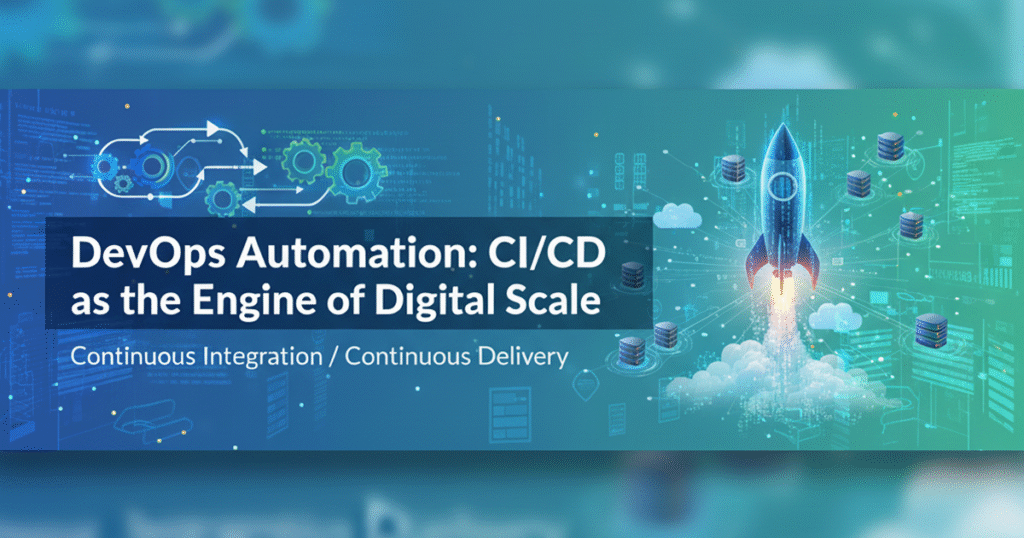Scaling digital products is no longer just about adding more servers or hiring more engineers. The real challenge is how fast and safely teams can ship software at scale. In today’s environment, where customer expectations are high and competition moves quickly, DevOps automation with CI/CD pipelines has become the engine that powers digital scale.
But here’s the catch: setting up a CI/CD pipeline is not the finish line. True scale happens when automation is combined with the right practices — platform engineering, observability, security, and continuous measurement.

CI/CD: More than a buzzword
At its core, Continuous Integration (CI) means merging code changes frequently and validating them through automated builds and tests. Continuous Delivery (CD) ensures those validated changes can move into production safely and consistently. Together, CI/CD turns releases from a risky, manual event into a predictable, routine operation.
Research like the DORA State of DevOps reports shows that organizations with strong CI/CD practices ship faster, recover quicker from failures, and deliver more reliable features. In short, CI/CD doesn’t just automate tasks — it sets the foundation for scaling without chaos.
What makes CI/CD the engine of scale?
1. Platform engineering: the multiplier effect
When every team builds their own pipelines, duplication and inconsistency creep in. Platform engineering solves this by creating self-service portals and reusable CI/CD templates. Developers get autonomy, while guardrails ensure reliability. This model has proven to be a force multiplier for scaling digital delivery.
2. GitOps: making deployments reproducible
GitOps takes the principle of Git as the single source of truth and extends it to deployments. Pipeline configurations, infrastructure, and application manifests all live in Git. This means deployments are auditable, reproducible, and rollbacks are as simple as reverting a commit — a game changer when scaling across many services.
3. Observability-driven DevOps: feedback that matters
Automation without feedback is blind. By integrating observability into CI/CD pipelines, organizations can make data-driven decisions during deployments. Metrics and SLOs can trigger automatic rollbacks during a failed canary release or stop a blue/green deployment before users are impacted. This tight feedback loop turns CI/CD into a self-correcting system.
4. Progressive delivery: speed without the blast radius
Techniques like feature flags, canary deployments, and blue/green rollouts allow teams to release often while controlling risk. With progressive delivery, CI/CD pipelines can push changes rapidly, while limiting exposure in case of failure. This is how companies release multiple times a day without burning out their ops teams.
5. DevSecOps & policy-as-code: scaling securely
Scaling isn’t just about speed — it’s about safety. Embedding security scans, compliance checks, and policy-as-code directly into pipelines ensures that every change meets security and compliance standards. Instead of slowing down releases, DevSecOps makes security part of the delivery flow.
6. Scaling the infrastructure behind CI/CD
As pipelines grow, they need distributed runners, caching, artifact registries, and tight Infrastructure as Code (IaC) integration to keep performance consistent. Pipeline optimization at this layer makes the difference between a 10-minute build and a 2-hour bottleneck.
7. AI in CI/CD: the new frontier
We’re starting to see AI applied in CI/CD — from detecting flaky tests to optimizing build times and even generating pipeline configurations. While promising, researchers warn that AI should be applied carefully, with human validation, to avoid introducing hidden risks.
8. MLOps: extending CI/CD to data and models
In machine learning projects, CI/CD needs an upgrade. Models and datasets require versioning, validation, and governance. MLOps adapts CI/CD practices for ML workflows, ensuring models are reproducible, traceable, and safely deployed into production.
A practical roadmap for organizations
1.Measure what matters — Track DORA metrics (lead time, deployment frequency, MTTR, change-failure rate) as a baseline.
2.Build a platform mindset — Provide teams with self-service CI/CD pipelines and infrastructure.
3.Adopt GitOps — Keep pipeline configs, manifests, and infrastructure declarative and version-controlled.
4.Bake in observability — Use SLO-driven checks and auto-rollbacks in deployments.
5.Shift security left — Integrate scanning and policy enforcement directly into pipelines.
6.Experiment with AI carefully — Start with low-risk use cases like test triage.
7.Optimize pipelines — Use distributed runners, caching, and artifact registries for scale.
8.For ML projects — Add model validation and data governance steps into your CI/CD flow.
A short story: scaling without burning out
Imagine a SaaS company with 40+ engineering teams. Before adopting modern CI/CD, they struggled with week-long release cycles and frequent production issues. After implementing platform-managed pipelines, GitOps workflows, and observability-driven deployments, they doubled release frequency while reducing incidents by 35%. The real win wasn’t just speed — it was scaling software delivery without scaling stress.
Conclusion
CI/CD is not just about automation; it’s about orchestration. When paired with platform engineering, observability, DevSecOps, and evidence-based measurement, CI/CD becomes more than a pipeline — it becomes the engine of digital scale.
Organizations that treat CI/CD as a strategic capability, not just tooling, will be the ones that move fastest, adapt quickest, and deliver the most reliable experiences at scale.
Frequently Asked Questions
1. What is CI/CD in DevOps and why is it important for scaling digital products?
CI/CD in DevOps automates code integration and deployment, helping businesses scale digital products faster. At Brigita, we use advanced CI/CD pipelines to deliver reliable releases for enterprises across India, UAE, Dubai, and the USA, improving speed, security, and performance.
2. How does Brigita use automation and AI to improve CI/CD pipelines?
Brigita integrates AI-driven quality checks, smart test automation, and predictive insights to optimize CI/CD workflows. This reduces deployment risks, speeds up delivery cycles, and enhances digital scalability for global clients.
3. What are the benefits of DevOps automation for enterprises in India, UAE, Dubai, and the USA?
DevOps automation helps enterprises reduce manual errors, accelerate releases, strengthen security, and improve operational efficiency. Brigita provides end-to-end automation that supports digital transformation across India, UAE, Dubai, and USA markets.
4. How does GitOps and Infrastructure as Code support CI/CD at scale?
GitOps and IaC centralize configuration in Git, enabling consistent, automated deployments. Brigita uses GitOps-ready models to deliver stable CI/CD pipelines that scale easily for multi-cloud environments across India, UAE, Dubai, and the USA.
5. Does Brigita offer secure DevOps and CI/CD solutions with built-in compliance?
Yes. Brigita provides DevSecOps-enabled CI/CD automation with policy-as-code, vulnerability checks, and AI-based security insights. This ensures compliance and safe releases for enterprises operating in India, UAE, Dubai, and the USA.
Search
Categories

Author
-
Hari Hara Subramanian H is a DevOps Engineer with over a year of experience in automating deployments and managing cloud infrastructure on AWS and Azure. He enjoys tackling real-world engineering problems and continuously learning new technologies. In his free time, he loves exploring tech blogs, working on personal projects, playing badminton, watching movies, exploring new places and cuisines, and has an enthusiasm for nature and music.
